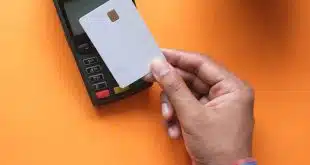The foundational technology for contactless credit cards has existed for some time, but we haven’t seen them adopted en masse yet, at least not Stateside. Much of that reluctance has to do with perceived obstacles or assumptions—perceptions that may or may not be entirely accurate.
Following are objective responses to some commonly held assumptions that turn up as barriers to consideration and adoption.
1. No retailers are accepting contactless.
In a recent webinar that we collaborated on, James Wester, research director for worldwide payment strategies at IDC, reported that more than 4 million merchants accept contactless payment in the U.S. Since 2014, that’s a jump from just 4% of merchants to 35%.
Although we aren’t yet able to refer to that subset as the majority, and there’s a wide variance in how many point-of-sale terminals any given retailer might operate, one out of every three merchants taking contactless payment is far beyond a blip on the radar. High-volume, recognizable brands including Whole Foods, Starbucks, Staples, Chevron, McDonald’s, Trader Joe’s, PetSmart, and many more are leading the charge toward contactless acceptance. But it’s not just the big players. Don’t believe me? Check out this Mastercard contactless locator that maps businesses of all sizes in any locale.
2. We need mobile payments to take off with consumers before contactless cards will.
It’s no secret that some parties have been underwhelmed by the limited uptake of mobile payments, even since the introduction of Apple Pay, Android Pay, and Samsung Pay. The common misconception here is that mobile payment adoption is a direct indicator of how often contactless cards would be used. In fact, it’s quite the opposite.
Contactless cards could actually be the bridge we’ve long needed from swipe or dip EMV cards to mobile payments. The user experience and form factor are much more familiar and don’t require new apps, expensive devices, or significant re-education. Contactless cards and mobile payments are similar in technical terms, but light years apart in practice and practicality.
3. There’s no real reason for contactless cards when banks and other issuers can be part of a mobile wallet.
Let me be clear: While there are many benefits to mobile wallets or standalone mobile payment apps, banks all but lose their branding leverage once their card is added to and buried in a virtual wallet. Consumers should absolutely be given their choice of payment method, but why wouldn’t a bank suggest a customizable, branded card as one of those contactless options? That can keep them top of mind and top of wallet with customers, while offering all the same convenience benefits as mobile payments.
4. Banks just completed their EMV card migrations and would have to foot another major bill all at once and on their own for contactless.
Yes, there were substantial overhead costs associated with the EMV card migration. But for most banks, those costs were distributed over the course of a couple years. The same can be true of transitioning to contactless cards. If banks start now and stick to a plan of reissuing cards as contactless on their standard expiration and replacement cycle, they’ll be able to spread the costs over multiple years again and not double up on reissuance. Besides, we don’t expect contactless cards to become the standardized form of plastic payment for a few years yet.
Beyond that strategic timing, banks should investigate subsidies from Visa and Mastercard. The payment brands stand to gain just as much from the increased volume of transactions, top-of-wallet mentality and, ultimately, revenue that contactless cards drive, so they’re often willing to pitch in and pay part of the costs.
5. Issuance is all or nothing, and “all” is overwhelming.
As part of the gradual reissuance process just discussed, contactless cards can be rolled out to select portfolios in priority order. Not only will this allow banks to field-test contactless cards and scale up, but it affords them the ability to give early access or special benefits to portfolios with spending incentives or global travel-value propositions.
6. Cards won’t be universally compatible with all contactless terminals.
It’s important to understand that there are two types of contactless terminal acceptance: magstripe data (MSD) and near-field communication (NFC). Sixty-five percent of current contactless terminals only accept the MSD variety. Once those older terminals are phased out of the marketplace, NFC (in any form factor) will work everywhere. Until then, contactless cards can easily be made backward-compatible, just as all mobile wallets are. This would allow for the widest acceptance and the most consistent user experience.
Contactless cards likely won’t take off tomorrow, and issuing them isn’t without its complexities. But, as with any new technology, misconceptions don’t do anyone any favors. Contactless cards might not end up being right for every issuer or everyconsumer, but now those issuers that are still wary will at least have the correct information to make that decision for themselves.
—Jack Jania is senior vice president of strategic alliances at Gemalto Inc., Austin, Texas.





